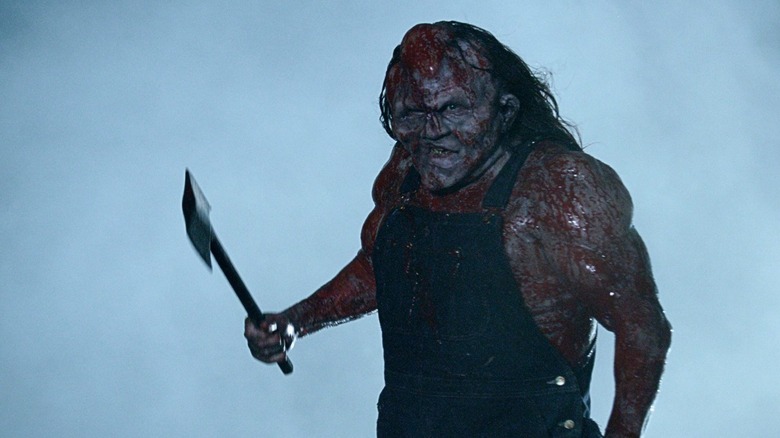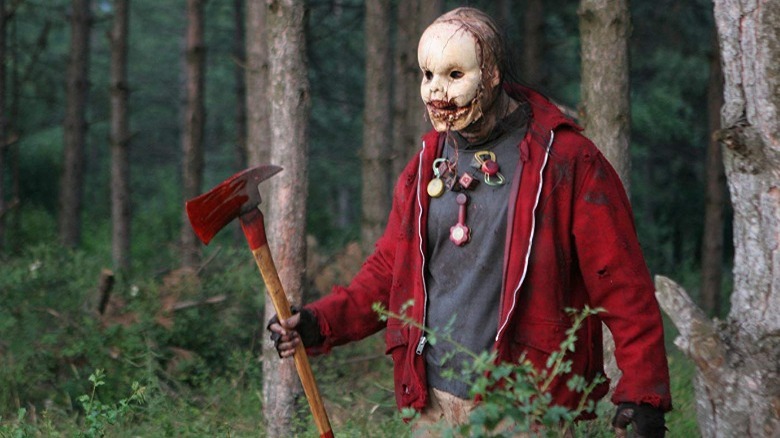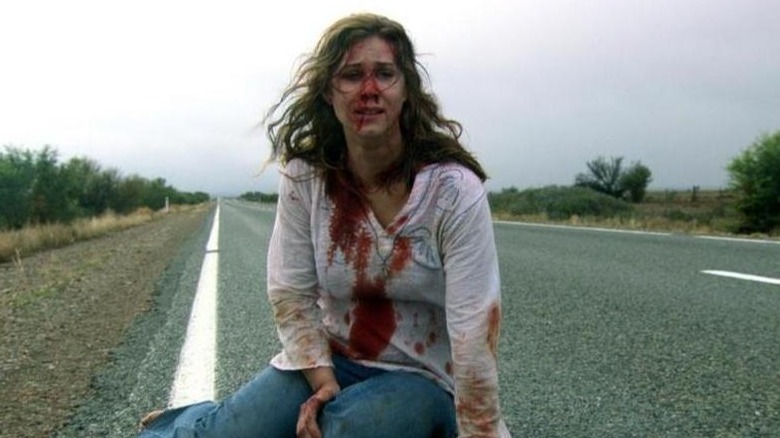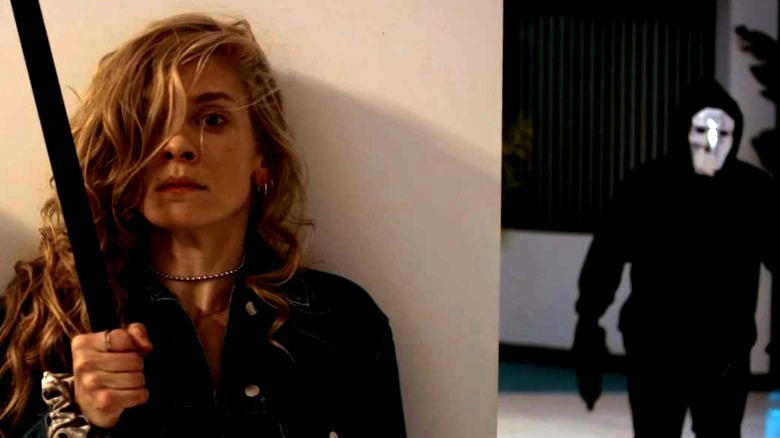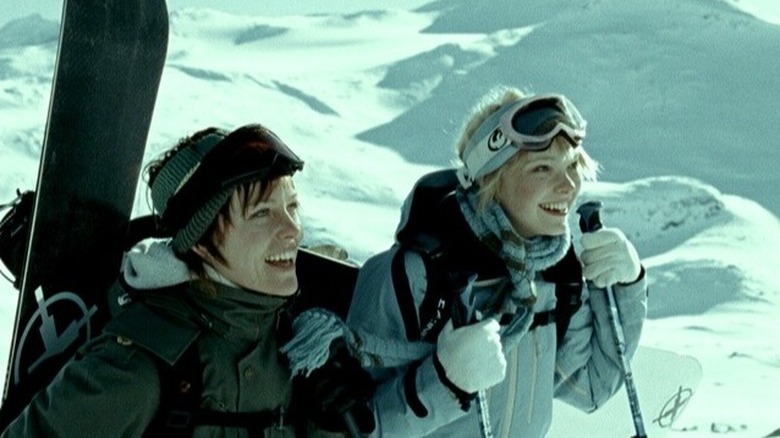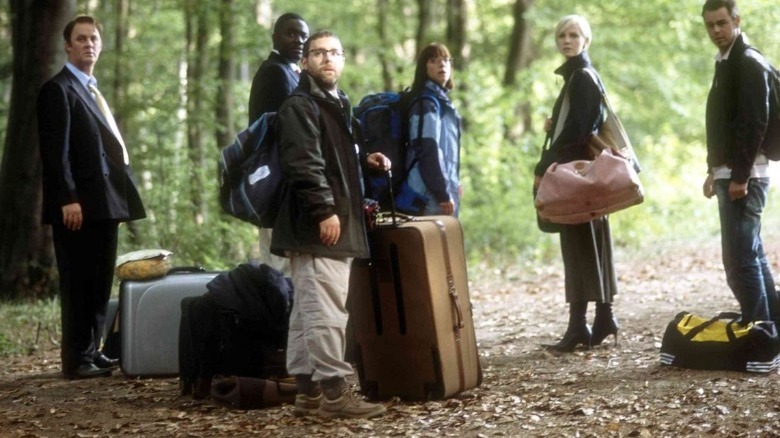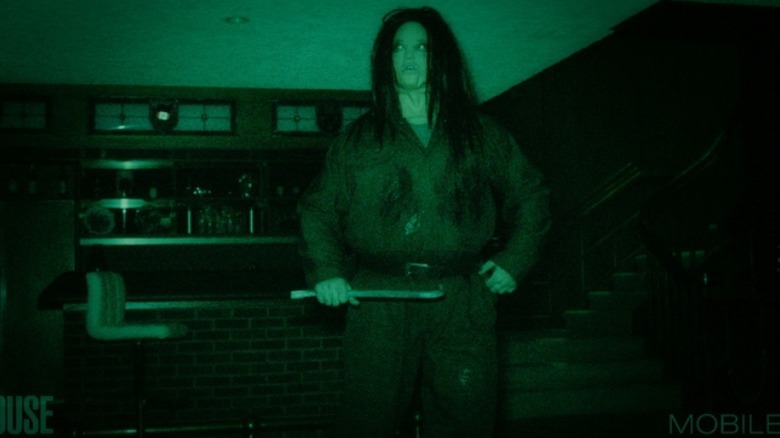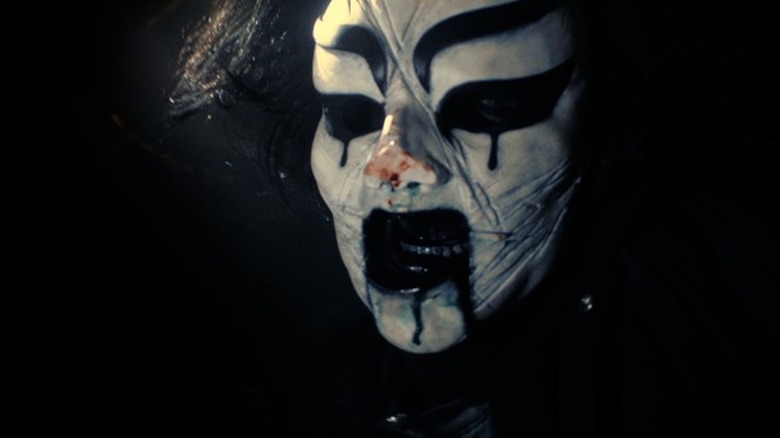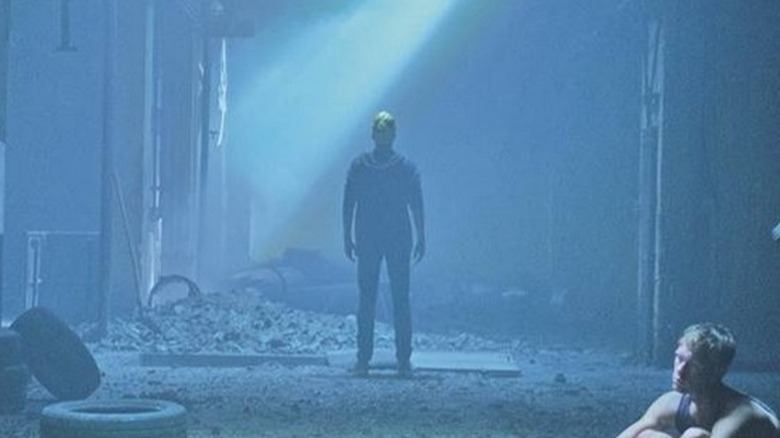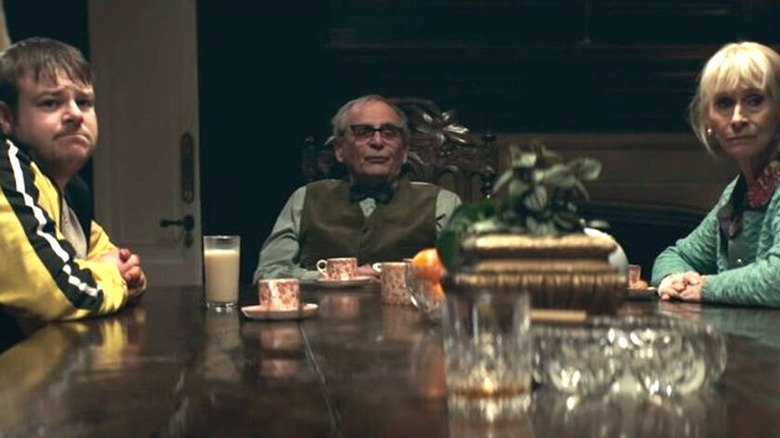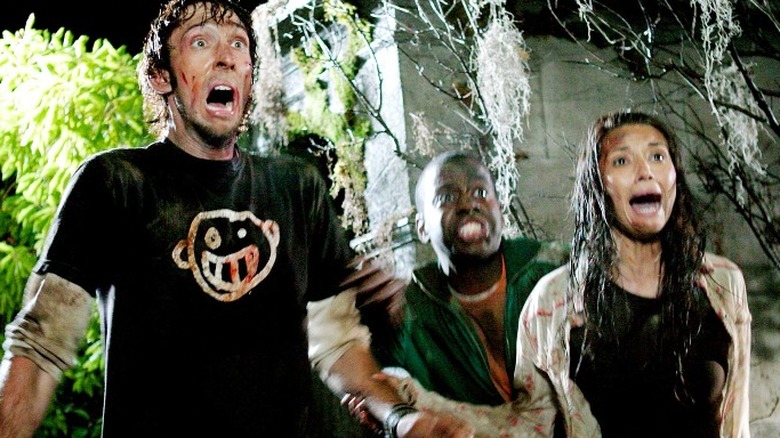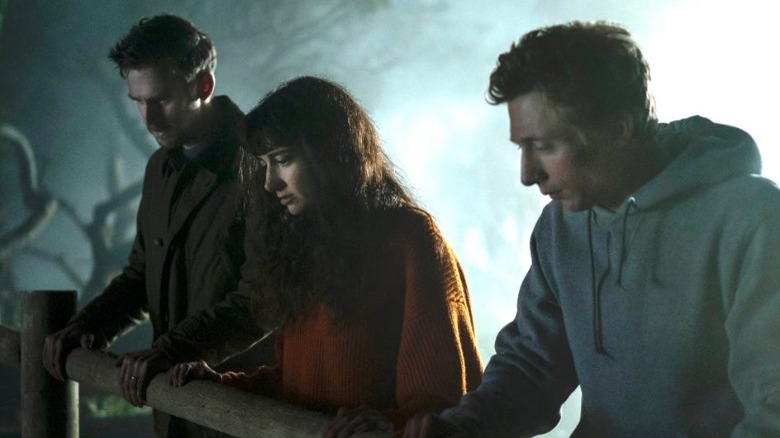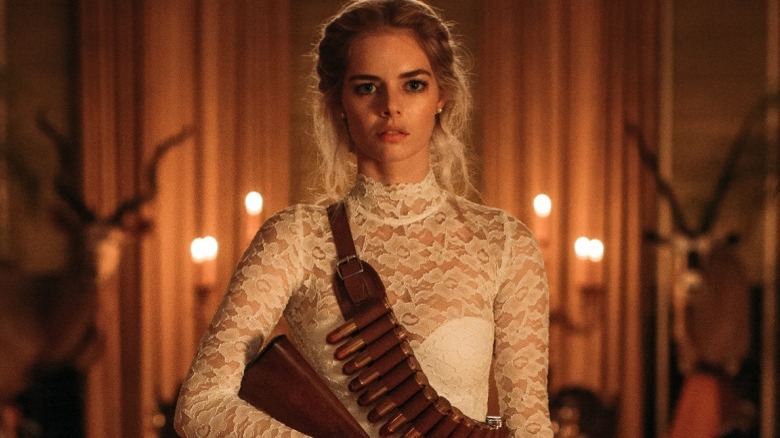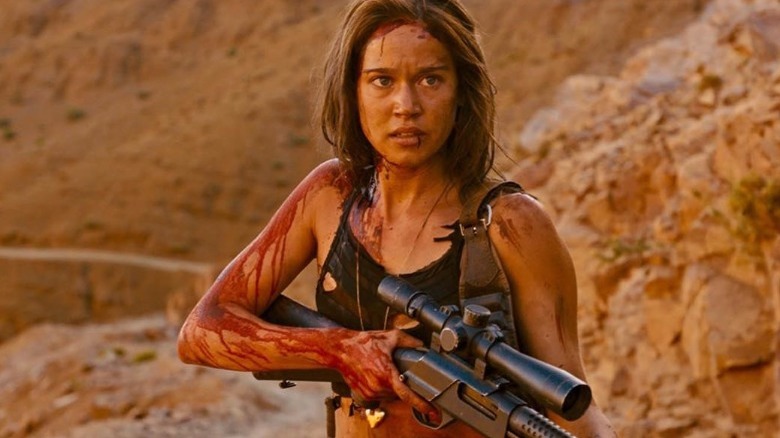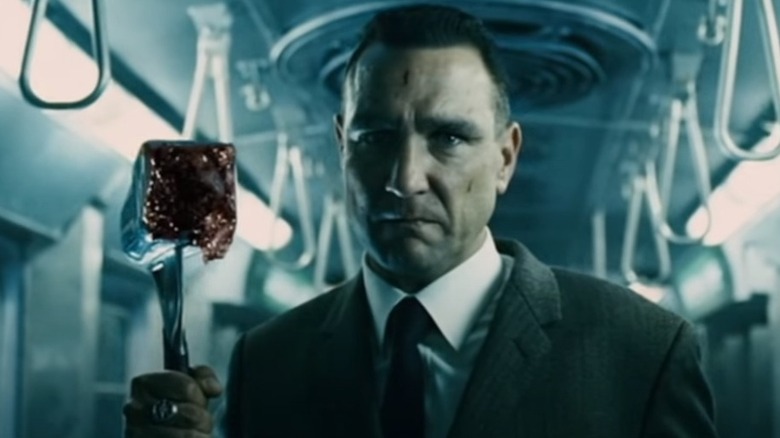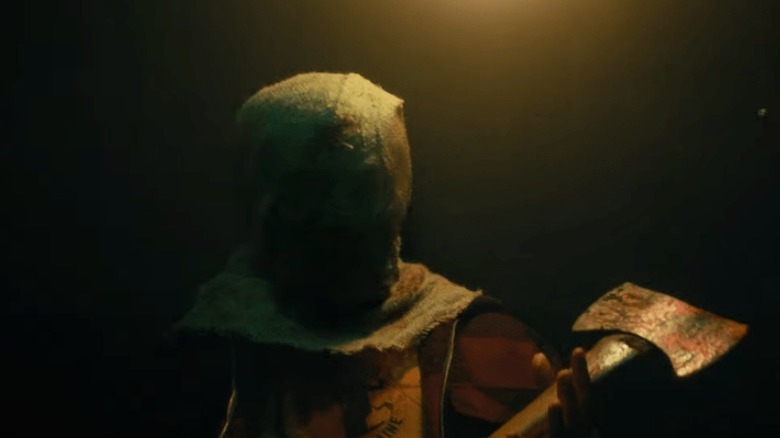15 21st Century Slasher Movies You Need To See
Prior to the past several years, slasher movies were all but dead. Unlike the unstoppable killers at its core, always rising for one last scare, the subgenre seemed to be down for good. Largely introduced in Alfred Hitchcock's "Psycho" and Michael Powell's "Peeping Tom" in the early 1960s, slasher movies came into their own in the following decade. Classics of the "Halloween" and "Black Christmas" sort were released, solidifying the subgenre as both a critical and artistic force the be reckoned with. The 1980s, however, were a true golden age for slashers with countless imitators cropping up, both independently and from the big studios. There were different killers in different settings with different weapons — almost like a game of Clue — mowing down hapless coeds in gruesome, mechanical fashion.
Wes Craven's "Scream" saved the subgenre in 1996 with its subversive, metatextual take on familiar material, leading the slasher film into the homestretch of its prime with releases like "Urban Legend" and "Cherry Falls." Soon, though, the subgenre died off, replaced by so-called torture porn and imported J-horror goodies. Yet, between its alleged death and contemporary rebirth, several noteworthy entries were released. Here, we'll be revisiting 15 21st century slashers you need to see, focusing exclusively on the underdogs. You won't see a revamped Michael Myers or Jason Voorhees here!
The Hills Run Red
"The Hills Run Red" went somewhat underappreciated outside the horror community when it was released straight to home video in September of 2009. In fact, its DVD cover art, featuring central killer Babyface holding an ax against a backdrop of Super 8 film, was seemingly designed for the last days of video store rentals. When in doubt, grab the movie with the ax-wielding, porcelain masked killer. Luckily, "The Hills Run Red" has more than just a gimmick.
Tyler (Tad Hilgenbrink) is obsessed with "The Hills Run Red," the title of the movie-within-the-movie. However, no copy is known to exist. He meets Alexa (Sophie Monk), the daughter of the film's missing director, and the two embark with friends to the woods where the last copy may be hidden. Of course, they encounter the real Babyface, and classic, ghoulish slaughter ensues. Although "The Hills Run Red" somewhat belies its homage to classic slashers with some borderline exploitative violence (though gory, '80s slashers were principally fun), it's one of the earliest and most accomplished examples of horror movies making the 1980s cool again. With a masked killer, gnarly gore, and plenty of unbelievable twists, it hits all the right spots.
Wolf Creek
When it was released on Christmas Day in the United States in 2005, "Wolf Creek" infamously earned an "F" Cinemascore, a metric used for gauging opening weekend audience perceptions. It was clear from the score "Wolf Creek" wasn't just failing to resonate — it was actively alienating its audience. Yet, it still managed a respectable $30 million worldwide gross, incentivizing a direct-to-video sequel and a television series. In other words, "Wolf Creek" defied the odds, likely on account of it being its generation's answer to "The Texas Chain Saw Massacre."
If that sounds like high praise, it's meant to be. Greg McLean's austere outback slasher follows three campers spending the night in Wolf Creek National Park where they run afoul of Mick Taylor (John Jarratt), a serial killer who has been murdering and disposing of tourists for several years. In the vein of Tobe Hooper's 1974 cult favorite, what follows is a stripped-down, matter-of-fact game of stalk-and-kill as the three campers endeavor to outwit Taylor and escape with their lives. The violence is stark, the acting naturalistic, and the tone abounding with nihilism. It's terrifying in its simplicity — a pitch-perfect example of homage done right.
Initiation
"Initiation" rocks. Largely ignored when released in May of 2021, it's one of the slasher subgenre's strongest showings in years, outranking even some of its legacy slasher counterparts. With a back-to-basics approach and a dollop of social commentary sprinkled in, it's fast, ferocious, and rich enough to work. Lindsay LaVanchy as Ellery Scott is investigating an alleged assault committed by her brother Wes (Froy Gutierrez) when a masked killer murders him and starts targeting others connected to the assault.
Director John Berardo, adapting his own short, is profoundly observant, capturing the ennui and guileless debauchery of young college students. The opening stretch, which takes place at a frat party, is so painfully naturalistic and real that it's liable to make the audience feel they're there, too — skunky beer, sticky floors, and all. Better still, the slasher elements blend perfectly with Berardo's commentary on campus violence, never letting one element distract from or undermine the other. For every tense chase scene, there's an honest account of what this means, not just within the context of higher education but society in general. In several years, don't be surprised to see "Initiation" regarded as a classic of the slasher movie subgenre.
Cold Prey
With American horror wrapped in the tendrils of "Saw" and "Hostel," Norway was kind enough to step in with a new slasher icon of its own. Oh, and what an icon it turned out to be! Roar Uthaug's "Cold Prey" (titled "Fritt Viltt" in Norwegian) is another example of a contemporary slasher projected over the template of the classics. You've got a group of young adults, a string of bad decisions, a remote location, and a masked baddie who doesn't take kindly to strangers. With some exquisite gore and genuine scares, "Cold Prey" didn't just temporarily revive the subgenre. It also proved slasher movies could be scary again.
Final girl Jannicke (Ingrid Bolsø Berdal) and her friends are snowboarding in the mountains when one of them suffers a severe injury. With no easy way down, they stop for the night at an abandoned mountain lodge — unaware that the Mountain Man, a hulking killer armed with a pickaxe, lives there too. The tension is suffocating, and Uthaug's constructs it with considerable craftsmanship. And the Mountain Man is a genuinely imposing villain. "Cold Prey" is as fun as it is scary, proving itself to be one of the early aughts' preeminent slasher films.
Severance
Horror-comedies are an absolute blast. However, they're exceptionally difficult to do effectively. Belied by Edgar Wright's Cornetto Trilogy, horror-comedies arguably have the hardest tonal balance to strike successfully. Leaning too far in any one direction runs the risk of undermining the opposite tonal end. Too many laughs neuter the terror while too many scares render the laughs uncomfortable. Christopher Smith's "Severance" is one of this century's best, a bloody, brazen hodgepodge of backwoods horror, torture porn, and "The Office"-esque laughs.
A group of co-workers travels to a remote mountain forest for a teambuilding retreat at a luxurious lodge — only, it isn't. Arriving at their destination, they find their accommodations in disrepair and their efforts at teambuilding annoying at best. Worse still, a group of homicidal Russian war criminals has targeted the group, deploying a diverse arsenal of weaponry (including bear traps and missile launchers) to take them out. Gut-bustlingly funny while genuinely tense in spots, "Severance" is a total delight.
Girl House
Trevor Matthews' "Girl House" has some questionable sexual politics. The story of a group of adult entertainment stars webcasting from a remote mansion and the hulking killer picking them off, "Girl House" is both progressive and reductive. As much as it empowers sex work and resists the conventional horror genre urge to equate it with a death sentence, the film isn't immune to long, drawn-out takes exploiting women for cheap thrills and nasty kills. Yet, aside from one other entry on this list, "Girl House" is probably the closest in style and tone to the slashers of yore, and that alone is worth celebrating.
Some filmmakers think a synth score and veiled '80s references are enough to imbue their slasher homages with the inimitable feel of the classics. Too often, they aren't. The old slashers had a distinct, subtle rhythm in the slow unfurling of stalk and slash scenes and a general mood that far exceeds a retro-style soundtrack. "Girl House," however, moves like the classics, characterizes its core cast like the classics, and balances quick jolts with pulse-pounding chase scenes like the classics. It does next to nothing to reinvent the old tropes, but sometimes, being good enough is good enough.
Stage Fright
"Stage Fright" is more than just a horror-comedy. It's a horror-comedy musical! With a delightful turn from the late Meat Loaf (Michael Lee Aday) as the director of a musical summer camp and guardian of Camilla (Allie MacDonald) and Buddy (Douglas Smith), two young adults whose mother was murdered backstage after the premiere of "Stage Fright's" riff on "The Phantom of the Opera," "The Haunting of the Opera."
Camilla, hearing the summer camp intends to put on a kabuki version of the infamous play, immediately auditions and lands the lead role (once held by her mother) much to the dismay of the other campers. Of course, this being a horror movie, someone else has donned the killer's iconic costume and is systematically killing off cast members as opening night approaches. With fantastic cameos, including a delightful appearance by Minnie Driver, top-notch gore, and genuine laughs, "Stage Fright" excels. The music is strong, and while not every joke lands ("Stage Fright" leans into musical theater stereotypes), it's consistently engaging. Charming, bloody, and addictive, "Stage Fright" is a sensational entry in an all-too-small subgenre.
Party Hard Die Young
"Party Hard Die Young" is not going to work for everyone. The core characters, other than final girl Julia (Elisabeth Wabitsch), are deeply obnoxious, and at times, genuinely malicious, exhibiting a blatant disregard for not only their own lives but the lives of their peers. Although the early going is fervent, intense, and violent, "Party Hard Die Young" stops midway through for a protracted introspective beat before picking back up at the climax. It's both a slasher movie and an anti-slasher movie that indulges in masked killer shenanigans while also endeavoring to do more.
Dominik Hartl's German-language shocker follows Julia (Elisabeth Wabitsch) and her friends as they travel to the coast of Croatia for a graduation party. Unbeknownst to the group, a masked killer is targeting them because of a secret they've all kept hidden for years. The kills are gorgeously rendered with set pieces to rival even big-budget Hollywood fare. Wabitsch is a compelling, proactive, and sympathetic final girl. It's a party, all right, and a pretty good one.
The Owners
"The Owners" is light on story and heavy on style. Yet, that isn't necessarily a bad thing. Directed by Julius Berg and adapted from the graphic novel "Une Nuit de pleine lune," "The Owners" follows a group of troublesome teens (including Maisie Williams of "Game of Thrones" fame) and their effort to break into the home of a rural doctor to rob him and his wife. As in "Don't Breathe" several years before, Dr. Huggins (Sylvester McCoy) and his wife Ellen (Rita Tushingham) aren't just a normal couple. They quickly turn the tables on the intruders, proving themselves to be formidable (and perhaps equally as criminal) foes.
Williams excels, never leaning too far into being the clichéd conscience of the group. The entire enterprise has a nasty, uneasy aura to it. The violence comes fast and hard, and at 90 minutes, it moves at a fast clip. Plus, there are several standout sequences, including a gonzo third act punctuated by a sudden aspect ratio shift that must be seen to be believed. "The Owners" is good old-fashioned slashing in the best way.
Hatchet
Victor Crowley really could have been the next slasher icon. Portrayed by Jason Voorhees himself, Kane Hodder, the character had all the trappings, including a distinct appearance and a deep mythos. Yet, (and this is in no way a bad thing), Adam Green's "Hatchet" is very much a movie for horror fans by horror fans. Across all four entries, the series abounds with familiar genre faces and features some of the most graphic slasher violence ever seen. Poor saps in Crowley's Louisiana swamp are ripped apart, gutted with buzz saws, and sanded down to nothing.
The first (and arguably best) entry conceptualizes what the series could have been. Although the carnage is unmatched (including the aforementioned belt sander scene), the scale is dialed back considerably. A group of tourists and one young woman with a personal vendetta (Tamara Feldman, with scream queen Danielle Harris taking over the role in subsequent entries) enter the swamp and run afoul of Victor Crowley, a behemoth who kills anyone unfortunate enough to enter his domain. Near invincible, exceptionally strong, and with a penchant for misusing power tools, he's a fantastic killer. While the series strays far from its roots, "Hatchet" endeavors to be both funny and scary. There's genuine tension beneath the buckets (and buckets) of blood. "Hatchet" delivers.
The Rental
Dave Franco's "The Rental" is a curious slasher outing. It's directed by a familiar face dabbling in horror filmmaking and stars a considerably better cast than the genre demands. It has Dan Stevens, Alison Brie, Sheila Vand, and Jeremy Allen White all turning in measured, naturalistic performances in what amounts to the Airbnb variant of Bryan Bertino's "The Strangers." The four star as two distinct couples embroiled in mumblecore, murderous mayhem. After renting a gorgeous home for the weekend, they begin to suspect something is awry. Their landlord is a creep, there are cameras hidden in the house, and to top it off, all of them are hiding secrets of their own.
Despite the caliber of talent involved, "The Rental" isn't much more than "vacation properties are scary." An effort is made to introduce threads of infidelity and interpersonal conflict, but none of that matters when the bodies start dropping. More than anything, it's a stark, impersonal slasher in the best way. As in "The Strangers," everything is arbitrary. These four were simply unlucky enough to be in the wrong place at the wrong time. The deaths happen quickly and unexpectedly, with Franco generating suffocating tension as everything slowly coalesces into chaos. There's nothing especially groundbreaking about "The Rental," but for fans of polished, unnerving slashers, it's worth the rental.
Ready or Not
Samara Weaving all but makes "Ready or Not" what it is. Directed by "Scream" reboot duo Matt Bettinelli-Olpin and Tyler Gillett, it stars "The Babysitter's" Weaving as Grace Le Domas, a former foster child who just recently married into the wealthy, powerful Le Domas family by way of son Alex (Mark O'Brien). After the ceremony, the entire family sits down for a game — a strange tradition Grace indulges in for good fun. A puzzle box is placed before her, and Grace is instructed to draw a game from within. She draws hide-and-seek. That's bad news for her.
As she hides, the family begins to arm itself with all manner of weapons. On account of a longstanding family curse, the Le Domas fortune is tied to this playful tradition. If a new spouse draws the hide-and-seek card (think of it as the family trump card) the rest of the family must kill them before dawn or die themselves. Weaving excels, shifting between Ellen Ripley's physical prowess and sheer incredulity as she grapples with in-laws trying to brutally murder her. It's funny, scary, and never takes either its violence or jokes too far. "Ready or Not" is a perfect medley of horror and comedy that makes it clear why Bettinelli-Olpin and Gillett were up to the task of rebooting the "Scream" franchise.
Revenge
"Revenge" does a lot of things, and it does all of them well. Nevertheless, there is an argument to be made that it's less a slasher movie and more a horror-tinged revenge saga. Like "Scream" before it, "Revenge" subverts a formula while resting squarely within it. Matilda Anna Ingrid Lutz stars as Jen, an American socialite who travels with her married boyfriend Richard (Kevin Janssens) to a gorgeous home in the middle of the desert. Soon, two of his hunting buddies arrive, and while it's all good fun and merriment for a while, Jen is assaulted by one of them while Richard is away. When he returns, he opts to prioritize himself and buy Jen's silence, prompting a chase through the desert.
It's no spoiler to reveal that, depending on viewer interpretation, Jen is killed. She tumbles over a cliff and is graphically impaled on a tree. However, she soon revives, brands herself with the image of an angel, and tracks the men down one by one. A slasher in reverse, "Revenge" is gloriously entertaining, cathartic, and excessively violent in the best way. It's a propulsive grindhouse throwback with modern sensibilities that shouldn't be missed.
The Midnight Meat Train
Did you know Hollywood heartthrob Bradley Cooper was in a graphic slasher movie? He stars in "The Midnight Meat Train," Ryuhei Kitamura's adaptation of famed horror author Clive Barker's short story of the same name. In the film, a serial killer known as the Subway Butcher has been slaughtering commuters. Photographer Leon Kaufman (Cooper) sees him as his ticket to stardom after he inadvertently catches photographic evidence of a murder in progress.
Leon makes a halfhearted attempt to report this to the police, but after he's met with skepticism, he sees the Subway Butcher as a way to make a quick buck while incidentally generating some goodwill. Consistently tense, "The Midnight Meat Train" is a city-wide cat-and-mouse slasher with one heck of an ending. Gory, stylishly filmed, and quite unlike anything that's come before (or since), it's a contemporary slasher done right by creatives who know the genre better than anyone.
Fear Street Part Two: 1978
Netflix's "Fear Street" experiment was wildly successful. The series is comprised of three slasher movies helmed by director Leigh Janiak that were released weekly in July of 2021. Loosely adapted from R.L. Stine's teenage horror series, Netflix's "Fear Street Trilogy" amped up the gore. A twisted tale of haunted lands and long-dead witches, the trilogy shifts between 1994 in the first entry, 1978 in the second, and both 1666 and '94 in the third. With a recurring cast of characters (with some actors playing different roles) it was aspirational in a way rarely seen in the slasher subgenre. Better still, it rocked.
"Fear Street Part Two: 1978" is arguably the most successful of the trilogy. As the middle chapter, it takes audiences back to one of the more infamous massacres in Shadyside, a town cursed by recurrent mass killing sprees over the entirety of its history. At Camp Nightwing, "Fear Street's" answer to Camp Crystal Lake from the "Friday the 13th" series, camper Tommy (McCabe Slye), a likable enough guy, is possessed by the spirit of an alleged witch named Sarah Fier and compelled to murder everyone else. With a level of brutality often avoided in the subgenre, several young campers are murdered. "Fear Street Part Two: 1978" is the scariest and most intense (but least ambitious) entry in the "Fear Street Trilogy." It harkens back to the slashers of the past while gorily carving out an identity of its own.
